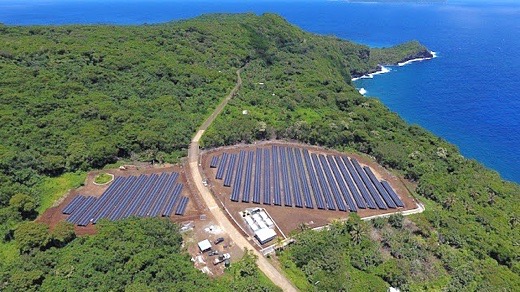SOURCE: Michael Sheehan (hanaleirivermichael@gmail.com)
SUBHEAD: Ta'u Island, in America Somoa, is 100% operating on solar power with 24/7/365 storage.
By Henry Curtis on 24 November 2016 for Ililani Media -
(http://www.ililani.media/2016/11/achieving-100-renewable-energy-one.html)

Image above: Aerial view of the solar power plant on Ta'u Island in America Samoa that is producing 100% of needed energy. From original article.
Ta'u Island used about 110,000 gallons of diesel last year. Now the island is powered by solar and batteries.
The 1.4 megawatt solar array consists of 5,328 solar panels provided by SolarCity. The battery system consists of 60 Tesla Powerpacks. They provide sufficient storage to provide all the needed electricity for three days. The system can be recharged in seven hours.
The solar microgrid with battery backup was installed and is being operated by the American Samoa Power Authority. Funding was provided by the American Samoa Economic Development Authority, the U.S. Environmental Protection Agency and the U.S. Department of Interior.
SolarCity market development director Jon Yoshimura stated,
Eons ago the south side of Ta'u ollapsed, leaving dramatic 1600-foot high cliffs that rise directly from the southern sea. SUBHEAD: Ta'u Island, in America Somoa, is 100% operating on solar power with 24/7/365 storage.
By Henry Curtis on 24 November 2016 for Ililani Media -
(http://www.ililani.media/2016/11/achieving-100-renewable-energy-one.html)

Image above: Aerial view of the solar power plant on Ta'u Island in America Samoa that is producing 100% of needed energy. From original article.
Ta'u Island used about 110,000 gallons of diesel last year. Now the island is powered by solar and batteries.
The 1.4 megawatt solar array consists of 5,328 solar panels provided by SolarCity. The battery system consists of 60 Tesla Powerpacks. They provide sufficient storage to provide all the needed electricity for three days. The system can be recharged in seven hours.
The solar microgrid with battery backup was installed and is being operated by the American Samoa Power Authority. Funding was provided by the American Samoa Economic Development Authority, the U.S. Environmental Protection Agency and the U.S. Department of Interior.
SolarCity market development director Jon Yoshimura stated,
"Before today, every time we turned on the light, turn on the television, turn on maybe the air conditioner, all of the cash registers in China, Vietnam, Saudi Arabia go 'cha-ching,' but not after today …We will keep more of that money here, where it belongs."Peter Rive, SolarCity co-founder and CTO, style="color: blue;">wrote a blog column about the successful application.
“Ta’u is not a postcard from the future, it’s a snapshot of what is possible right now. Renewable power is an economical, practical solution for a growing number of locations and energy needs, and islands that have traditionally relied on fossil fuels can easily transition to microgrids powered by solar and storage today.”
The island is where the 23-year-old anthropologist Margaret Mead conducted her dissertation research in Samoa in the 1920s, published in 1928 as Coming of Age in Samoa.
Ta‘ū is the largest island in the Manu‘a Group and the easternmost volcanic island of the Samoan Islands. The island is 17 square miles in size and has a population of almost 900 people.
The summit of the island, called Lata Mountain, is at an elevation of 3,054 feet, making it the highest point in American Samoa. All of the southeastern half of Ta‘ū—including all of the rainforest on top of Lata Mountain and within the caldera—and southern shoreline and associated coral reefs are part of the National Park of American Samoa. The park includes the ancient, sacred site of Saua, considered to be the birthplace of the Polynesian people.
The Teslarati blog noted,
“Diesel in itself is made from chemicals including sulfates, ammonium, nitrates, elemental carbon, condensed organic compounds, and even carcinogenic compounds rich in heavy metals such as arsenic, selenium, cadmium and zinc..
Diesel exhaust poses major health hazards, contributes to climate change, is costly to ship, and can lead to frequent temporary blackouts. With a dramatic decrease on diesel reliance, Ta’u, through the SolarCity renewable microgrid, will experience valuable community life enhancements that can increase local control and community independence.
No comments :
Post a Comment